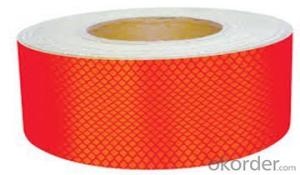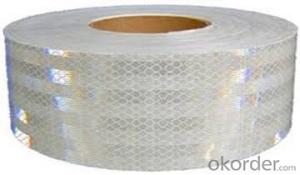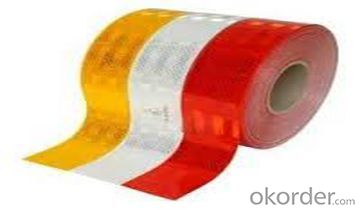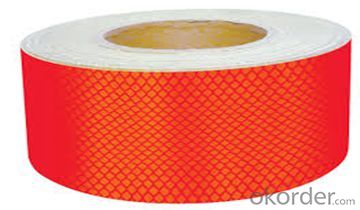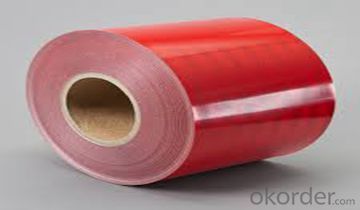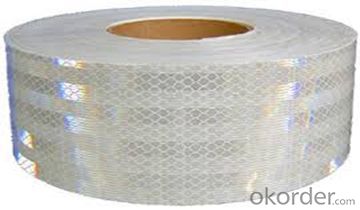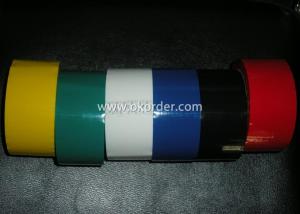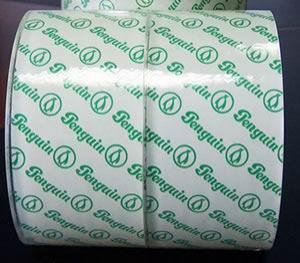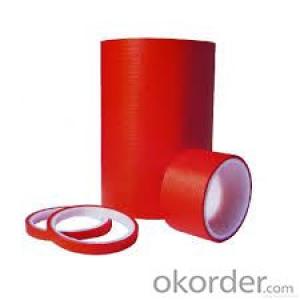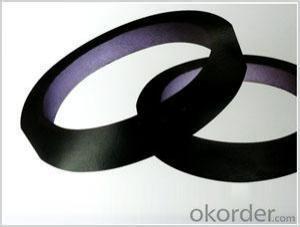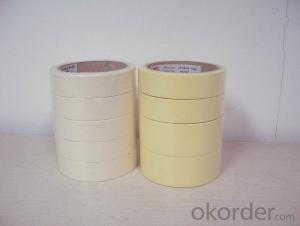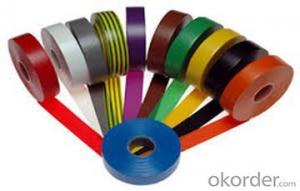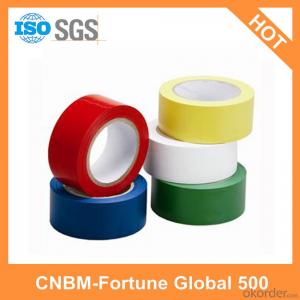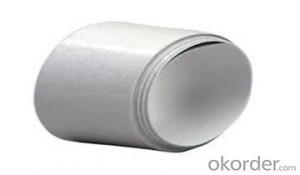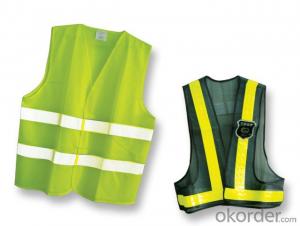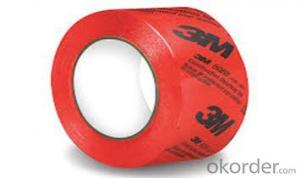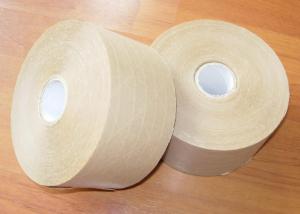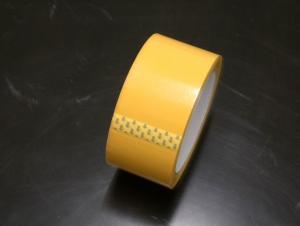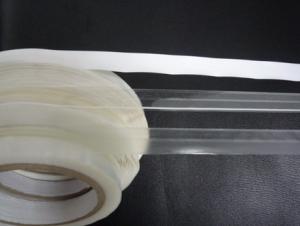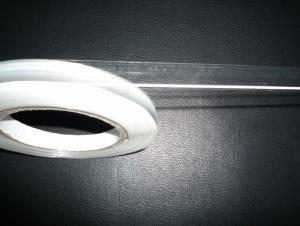Packaging Scotch Tape 3M Reflective Tapes for Clothing Fabric Tape Water Based Acrylic
- Loading Port:
- Tianjin
- Payment Terms:
- TT OR LC
- Min Order Qty:
- 1000 roll
- Supply Capability:
- 500000 roll/month
OKorder Service Pledge
OKorder Financial Service
You Might Also Like
1.Product details
Brand Name | reflective tape for clothing fabric tape water based acrylic |
Color | Sliver |
Material | 100 % Polyester or TC (65% polyester and 35% cotton) |
Reflective Coefficient | R> 420 cd/lx.m2 |
Washing Instruction | Home wash 50 cycles @ 60°C (ISO6330) |
Certification | OEKO-TEX 100; EN20471; ANSI/ISEA 107-2010 Level 2; AS/NZS 1906.4-2010; CSA-Z96-02 |
Width | 1cm-135cm |
Packing | 200meters/R or 100meters/R or as per customers’ request |
Delivery time | 7-15 days after receiving payment |
Departure Port | Tianjin |
2.Packaging & Delivery
200meters/roll, packed in carton box
Shipped in 15 days since receiving payment
3.Product certification and Factory
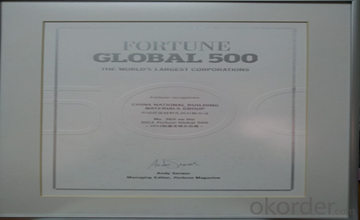
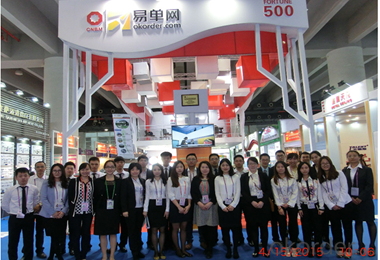
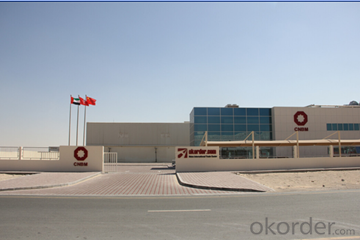
4.Company information
CNBM International Corporation (CNBM International) is the most important trading platform of CNBM Group Corporation, a state-owned company under the direct supervision of State-owned Assets Supervision and Administration Commission of the State Council.
We specilized in Duct tape, Masking tape, Double sided tissue tape, PET tape, Foam tape, PVC tape, Warning tape, Fiberglass tape…Now we have exported our products to over 30 countries and regions like Europe ,South / North America ,Southeast Asia etc and gained customer's respect and continued businesses. Based on our good quality , reasonable price, good after-sale service, we enjoyed good reputation in the international market.
Warmly welcome your any inquiries or request ! You will be impressed by our superior quality, quick delivery date and attractive price. Contact us now!
5.Our service
(1)24 hours prompt reply by email or telephone or messenger.
(2)Standard size have stock, immediately delivery once your purchase
(3)10 days delivery containers for out of stock
(4)Can combine containers with multiple insulation products for your different demand
(5)No quantity limit, from 1 rolls to full container, at your choose and demand!
6.FAQ:
Q1: Are you manufacturer or trading company?
A: We are professional Manufacturer.
Q2: Can I use our own designing?
A: Yes, size, printing, color, paper core, logo, carton box can be customized.
Q3: May I have samples?
A: Yes, Free samples available and freight collect by DHL, FEDE
- Q: What is the difference between acrylic and hot melt adhesive for packaging tape?
- Acrylic and hot melt adhesives are two common types of adhesives used for packaging tape, and they have some key differences. One major difference is the bonding strength. Hot melt adhesive is known for its excellent bonding strength, making it suitable for heavy-duty applications. It creates a strong and durable bond that can withstand rough handling and varying temperatures. On the other hand, acrylic adhesive typically offers a lower bonding strength compared to hot melt adhesive. While it is still suitable for most general packaging needs, it may not be as ideal for heavy or bulky items. Another difference lies in the application process. Hot melt adhesive is applied in a molten state and solidifies upon cooling. It is typically dispensed using a hot melt glue gun or a hot melt applicator. The quick setting time of hot melt adhesive allows for fast packaging operations, making it popular in high-volume settings. In contrast, acrylic adhesive is applied in a liquid form and requires some time to cure and form a strong bond. It can be applied using a hand dispenser or a tape gun, and it usually requires some pressure for optimal adhesion. Additionally, hot melt adhesive offers good adhesion to a wide range of surfaces, including cardboard, plastics, and metals. It is highly versatile and can be used for various packaging materials. Acrylic adhesive also adheres well to different surfaces, but it may not have the same level of compatibility with certain low-energy surfaces, such as polyethylene or polypropylene. Furthermore, temperature resistance is another factor to consider. Hot melt adhesive performs well in both high and low temperatures, maintaining its bonding strength. It can withstand freezing temperatures and heat without compromising its adhesive properties. Acrylic adhesive, while generally offering good temperature resistance, may not be as effective in extreme conditions, particularly at very high or low temperatures. In summary, the main differences between acrylic and hot melt adhesives for packaging tape lie in bonding strength, application process, surface compatibility, and temperature resistance. While hot melt adhesive provides superior bonding strength, fast setting time, and excellent temperature resistance, acrylic adhesive offers versatility, ease of application, and good adhesion to most surfaces. The choice between the two depends on the specific packaging needs, materials, and environmental conditions.
- Q: How do I remove packaging tape without damaging the surface?
- To remove packaging tape without damaging the surface, you can follow these steps: 1. Start by lightly heating the tape using a hairdryer on a low setting. The heat will soften the adhesive, making it easier to remove. 2. Gently lift one corner of the tape using your fingernail or a plastic scraper. Be careful not to use sharp objects that could scratch the surface. 3. Slowly peel the tape back at a 180-degree angle, applying steady and even pressure. If the tape resists, stop and apply more heat to soften the adhesive further. 4. If there is any residue left behind, you can use rubbing alcohol or a mild adhesive remover. Apply a small amount to a soft cloth and gently rub the residue until it lifts off. 5. Once the tape and residue are removed, clean the surface with a mild soap and water solution to remove any remaining adhesive or residue. Remember to always test any cleaning solution on a small, inconspicuous area first to ensure it doesn't damage the surface.
- Q: What are the advantages of using packaging tape over other sealing methods?
- One advantage of using packaging tape over other sealing methods is its versatility. Packaging tape can be used to seal a wide variety of materials, such as cardboard boxes, plastic bags, and envelopes. It provides a strong and secure seal that can withstand the rigors of shipping and handling. Additionally, packaging tape is easy to use, requiring minimal effort and time for application. It is also cost-effective, as a small amount of tape can go a long way in sealing multiple packages. Lastly, packaging tape is often available in different sizes, colors, and strengths, allowing for customization and meeting specific packaging needs.
- Q: What are the best practices for storing packaging tape rolls?
- The best practices for storing packaging tape rolls include keeping them in a cool and dry environment to prevent moisture damage, storing them upright to avoid deformation, ensuring they are tightly sealed to maintain adhesive quality, and keeping them away from direct sunlight and extreme temperatures to prevent tape degradation. Additionally, it is advisable to organize and label tape rolls for easy identification and access.
- Q: Can packaging tape be used for outdoor applications?
- Yes, packaging tape can be used for outdoor applications. However, it is important to note that not all packaging tapes are designed for outdoor use. Regular packaging tapes may not withstand extreme weather conditions or exposure to UV rays, which can cause them to deteriorate or lose their adhesive properties. To ensure the durability and effectiveness of packaging tape for outdoor applications, it is recommended to use specialized outdoor or weather-resistant packaging tapes. These tapes are designed with stronger adhesives and materials that can withstand outdoor elements such as rain, heat, cold, and sunlight. They are often made with materials like acrylic or rubber, which provide better resistance to moisture, temperature changes, and UV rays. When selecting packaging tape for outdoor applications, it is important to consider the specific requirements of the intended use. This may include factors such as the duration of exposure to outdoor conditions, the weight and size of the package, and the surface to which the tape will be applied. By choosing the appropriate outdoor packaging tape, you can ensure that your packages remain securely sealed and protected, even in outdoor environments.
- Q: What is the difference between acrylic and hot melt packaging tape?
- Acrylic and hot melt packaging tapes are both commonly used for sealing boxes and packages, but they have distinct differences in terms of their adhesive properties and performance. Acrylic packaging tape is known for its clarity and transparency, making it ideal for applications where the appearance of the package is important. It is also resistant to yellowing and aging, ensuring that the tape remains clear and does not become brittle over time. Acrylic tape has a strong initial tack, meaning it adheres quickly to surfaces upon application. However, it may not perform as well in extreme temperatures, as it can lose its adhesive strength when exposed to high heat or cold conditions. On the other hand, hot melt packaging tape is made from a synthetic rubber adhesive that is applied to the tape as a hot liquid. This type of tape offers superior adhesion and bond strength, making it suitable for heavy-duty or challenging packaging tasks. It has excellent resistance to temperature changes, maintaining its adhesive properties even in extreme conditions. Hot melt tape is also known for its quick and easy release, making it convenient for high-volume packaging operations. In summary, while both acrylic and hot melt packaging tapes are effective for sealing boxes, they have different strengths and weaknesses. Acrylic tape is best for applications where clarity, aging resistance, and initial tack are priorities. Hot melt tape, on the other hand, excels in terms of adhesion strength, temperature resistance, and ease of use. Ultimately, the choice between the two depends on the specific requirements and conditions of the packaging task at hand.
- Q: What are the benefits of using silent packaging tape?
- Using silent packaging tape offers several advantages. Firstly, it guarantees a noiseless packaging experience, which is especially valuable in settings that require silence, such as offices, libraries, or other tranquil spaces. By eliminating the loud noises typically associated with regular packaging tape, silent tape helps maintain a serene and peaceful atmosphere. Secondly, employees who regularly handle packaging tasks prefer silent packaging tape. The absence of noise during the taping process reduces the risk of stress or fatigue caused by noise, contributing to a more comfortable work environment. This, in turn, can lead to increased productivity and employee satisfaction. Furthermore, silent tape is an excellent choice for businesses that prioritize customer satisfaction. When packaging items for shipment, particularly delicate or fragile ones, using silent tape ensures a professional and refined appearance. The lack of loud noise during the packaging process also prevents any potential disturbance or annoyance to customers, both during the packaging phase and upon receiving their packages. In addition, silent packaging tape is often crafted with high-quality adhesive properties, providing a secure and long-lasting seal that keeps packages intact during transit. This reduces the chances of damaged goods and the associated costs of having to resend or replace items. Lastly, silent tape is frequently made from eco-friendly materials, making it advantageous for businesses aiming to minimize their environmental impact. By opting for silent packaging tape made from recyclable or biodegradable materials, companies can align their packaging practices with their sustainability goals. In conclusion, the benefits of using silent packaging tape include noise reduction, improved employee satisfaction and productivity, enhanced customer experience, secure sealing, and eco-friendliness. By choosing silent tape, businesses can create a more efficient, pleasant, and environmentally conscious packaging process.
- Q: How do I choose the right packaging tape for my needs?
- To guarantee your packages are securely sealed during transit, it is crucial to make a careful decision when selecting the appropriate packaging tape. Here are some factors to take into account: 1. Strength and durability: Take into consideration the weight and nature of your packages. For heavy or bulky items, it is advisable to choose a tape with high tensile strength that can withstand rough handling. Look for tapes made from materials like fiberglass or reinforced with polyester fibers. 2. Adhesive type: Various packaging tapes use different types of adhesives. Acrylic adhesive is commonly used and provides a good balance of performance and affordability. For challenging surfaces or extreme conditions, consider using hot melt adhesive, which offers superior bonding strength. Furthermore, water-activated tape, also known as gummed paper tape, forms a permanent bond when moistened, providing enhanced security. 3. Width and length: Determine the appropriate width and length of tape based on the size of your packages. Thicker tapes are generally more durable, and longer rolls may be more cost-effective for high-volume packaging. 4. Transparency and aesthetics: If you desire a professional appearance for your packages or need to easily see the contents, opt for clear or transparent packaging tape. However, if appearance is not a concern, colored tape can aid in easy identification or branding purposes. 5. Environmental considerations: If you are environmentally conscious, look for packaging tapes made from eco-friendly materials or those that are recyclable. Some tapes are water-based, solvent-free, or made from renewable resources, making them a greener choice. 6. Dispenser compatibility: Take into account the type of tape dispenser you have or plan to use. Ensure that the tape you choose is compatible with your dispenser, as certain tapes necessitate specific types of dispensers. 7. Cost: Finally, compare prices and consider your budget. However, bear in mind that sacrificing quality for a lower price may result in inadequate tape performance and potential damage to your packages. By considering these factors, you can make an informed decision and select the appropriate packaging tape that best suits your needs, ensuring your packages arrive securely and intact.
- Q: Can packaging tape be used for sealing cardboard boxes?
- Yes, packaging tape is commonly used for sealing cardboard boxes as it provides a strong and secure bond.
- Q: How does packaging tape compare to duct tape in terms of strength and durability?
- Packaging tape and duct tape display notable disparities in terms of strength and durability. Packaging tape primarily serves the purpose of sealing boxes and securing lightweight packages, rendering it appropriate for general household use or tasks that involve low levels of exertion. It typically possesses a lower tensile strength and may be more susceptible to tearing or breaking when exposed to substantial stress or weight. Conversely, duct tape possesses a well-established reputation for its remarkable strength and durability. It is precisely engineered to provide a sturdy and long-lasting grip, making it the preferred choice for demanding tasks and repairs requiring a robust adhesive. Duct tape is composed of a resilient woven fabric backing coated with a durable adhesive, resulting in a tape capable of enduring high levels of tension and resisting tearing or breaking even in extreme conditions. While packaging tape is designed for temporary applications, duct tape is commonly employed in more strenuous and enduring projects, such as mending or fortifying items, bundling heavy objects, or even constructing provisional structures. Its versatility and superior strength make it a dependable option in situations where durability and resilience are of paramount importance. To summarize, packaging tape and duct tape diverge in their intended uses and capabilities. Packaging tape is suitable for lightweight applications and the sealing of boxes, whereas duct tape excels in heavy-duty tasks and offers outstanding strength and durability.
Send your message to us
Packaging Scotch Tape 3M Reflective Tapes for Clothing Fabric Tape Water Based Acrylic
- Loading Port:
- Tianjin
- Payment Terms:
- TT OR LC
- Min Order Qty:
- 1000 roll
- Supply Capability:
- 500000 roll/month
OKorder Service Pledge
OKorder Financial Service
Similar products
Hot products
Hot Searches

